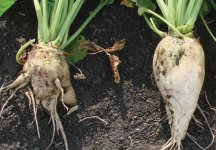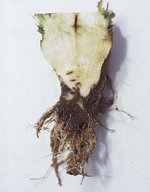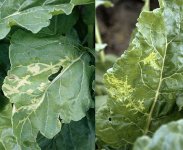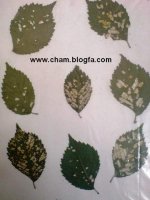You are using an out of date browser. It may not display this or other websites correctly.
You should upgrade or use an alternative browser.
You should upgrade or use an alternative browser.
مسابقه ••• هر کی گفت مشکل چیه؟
- شروع کننده موضوع کلروفیل
- تاریخ شروع
Septoria Leaf Spot بيماري لكه برگي سپتوريايي؟
خب گویا درسته... هرچند من هدفم یه بیماری دیگه بود که بذارم که اشتباها این از آب در اومد....
نام خود عکسم خوب کمک کرد!
سوال بعد رو آقای ابوذر بذارند که زودتر جواب دادن...
آخرین ویرایش:
مگه عكسه اسم هم داشت؟ پس چرا من نديدم؟خب گویا درسته... هرچند من هدفم یه بیماری دیگه بود که بذارم که اشتباها این از آب در اومد....
نام خود عکسم خوب کمک کرد!
سوال بعد رو آقای ابوذر بذارند که زودتر جواب دادن...
من اين عكسو سركلاس ديده بودم
زودتر عكس بعد رو بزاريد
Septoria Leaf Spot of Tomato
Mary Ann Hansen, Extension Plant Pathologist, Department of Plant Pathology, Physiology and Weed Science, Virginia Tech. Adapted from a previous publication by R.C. Lambe
Septoria leaf spot of tomato, caused by the fungus Septoria lycopersici, is one of the most common and destructive diseases of tomato in Virginia. The fungus can cause severe leaf spotting and defoliation is common following severe infection. Heavy leaf loss during wet seasons leads to sunscalding of fruit and failure of fruit to mature properly.
Symptoms
Numerous, small, watersoaked spots, which are the first noticeable characteristic of Septoria leaf spot, appear on the lower leaves after fruit set. Spots enlarge to a uniform size of approximately 1/16 to 1/4 inch in diameter. They have dark brown borders and tan or light colored centers. Yellow haloes often surround the spots. Severely infected leaves die and drop off. Septoria leaf spot is easily distinguished from early blight, another foliar disease of tomato, by the uniform, small size of the spots and the lack of concentric rings in the spots; however, Septoria leaf spot is sometimes confused with bacterial spot of tomato. The presence of fruiting bodies of the fungus, visible as tiny black specks in the centers of the spots, confirms Septoria leaf spot.
file:///C:/Users/rg/Desktop/Septoria Leaf Spot of Tomato - Home - Virginia Cooperative Extension_files/L_IMG_fig1.jpgFig. 1. Small, uniform, brown spots caused by Septoria lycopersici on tomato leaves. Chlorosis is often associated with the spotting. (Photo by R.C. Lambe)
Favorable weather permits infection to move up the stem, causing a progressive loss of foliage from the bottom of the plant upward. Plants appear to wither from the bottom up. Loss of foliage causes a decrease in the size of the fruits and exposes fruit to sunscald. Spotting of the stem and blossoms may also occur.
Disease Cycle
Septoria lycopersici overwinters in old tomato debris and on wild solanaceous plants, such as ground cherry, nightshade, and jimsonweed. Seeds and transplants may also carry the fungus. The disease is favored by moderate temperatures and abundant rainfall. Spore production is abundant when temperatures are 60°-80°F (15.5°-28°C). Spores are easily spread by wind and rain. Infection occurs on lower leaves after the plants begin to set fruit.Control
Cultural Control
- Dispose of crop refuse by plowing under or composting.
- Control weeds in and around the edge of the garden.
- Rotate tomatoes with cereals, corn, or legumes. A 4-year rotation is recommended where disease has been severe.
Chemical Control
- Apply fungicides on a preventative schedule before the disease first appears on the lower leaves. Begin sprays when the first fruits of the first cluster are visible after blossom drop. Apply fungicides every 7 to 10 days or more often when the weather is warm and wet. In home gardens the fungicides, chlorothalonil (e.g. Daconil 2787) or maneb (e.g. Maneb), can be used.
- In commercial plantings, chlorothalonil (e.g. Bravo, Terranil) and maneb (e.g. Dithane Rainshield NT, Penncozeb) can be rotated with the systemic fungicide, azoxystrobin (e.g. Quadris), every 7 days. Alternating sprays is important in order to delay the development of resistant strains of the fungus to azoxystrobin. Refer to the current Virginia Pest Management Guide for Home Grounds and Animals(VCE Publication 456-018) or Commercial Vegetable Production Recommendations (VCE Publication 456-420) for details on fungicide application rates and timing.
Resistance
- No resistant cultivars are available.
ویروس رایزمونیای چغندر؟
بله درسته جواب ویروس رایزومونیای چغندر (Beet Necrotic Yellow Vein Virus) که با قارچ Polymyxa betae منتقل می شود.ویروس رایزمونیای چغندر؟
امیر مسعود جان حالا میتونید اون بیماری که مدنظرتون بود را بزارید...
بله درسته جواب ویروس رایزومونیای چغندر (Beet Necrotic Yellow Vein Virus) که با قارچ Polymyxa betae منتقل می شود.
امیر مسعود جان حالا میتونید اون بیماری که مدنظرتون بود را بزارید...
بله ممنون فقط اصلاح کنم ویروس رایزومونیای چغندر به وسیله چند نوع شته به طریق نیمه پایا منتقل میشه.
اشتباه میکنی امیر مسعود جان ویروس ریزومونیا (ریش ریشی) چغندرقند با قارچ منتقل میشه! فکر میکنم شما با ویروس کرلی تاپ اشتباه گرفتید برای اینکه مطمئن بشی لینک زیر را ببین:بله ممنون فقط اصلاح کنم ویروس رایزومونیای چغندر به وسیله چند نوع شته به طریق نیمه پایا منتقل میشه.
http://sabzineh.ir/disease/cdisease/95-Beet-necrotic-yellow-vein-virus.html
[h=3]بیماری رایزومونیای چغندر قند Beet necrotic yellow vein virus[/h]
این بیماری را با نامهای دیگری به نام زردی نکروتیک رگبرگ و ریشه ریشی نیز می شناسند. بیماری در فارس بسیار شایع است و خسارات زیادی را در حالت اپیدمی به بار می آورد. عامل بیماری ویروسی از گروه Tobamovirus است. ویروس از طریق زئوسپورهای قارچ Polymyxa betae منتقل می شود و پایداری ویروس در اسپورهای استراحتی قارچ می باشد.
در صورت آلودگی چغندر قند به این ویروس برگهای خارجی حالت پژمردگی به خود می گیرند یا بعضی از برگها خشک می شوند. در مقطع ریشه دوایر قهوه ای متحدالمرکز دیده می شود. از دیگر علائم مهم بیماری زردی رگبرگها است. بیماری بروی ریشه هم علائم خاصی ایجاد می کند که در تشخیص بیماری مهم است. ازجمله این علائم وجود تعداد زیادی ریشه فرعی روی ریشه اصلی می باشد. بدین صورت که ریشه اصلی به یکباره باریک شده و ریشه های فرعی زیاد می شوند. بیماری ریشه ریشی شبیه علائم نماتد سیستی بروی ریشه است ولی از وجود سیستها خبری نیست.
کنترل:
با توجه به نوع عامل و شیوه انتقال و پایداری ویروس در خاک باید سعی شود از سیستم پیشگیری استفاده شود.
1. جلوگیری از آلوده شدن مزارع
2. استفاده از ارقام مقاوم
3. شخم عمیق
4. در صورت امکان عدم استفاده از کود حیوانی و آبیاری غرقابی
5. مبارزه بیولوژیک با قارچ ناقل
این بیماری را با نامهای دیگری به نام زردی نکروتیک رگبرگ و ریشه ریشی نیز می شناسند. بیماری در فارس بسیار شایع است و خسارات زیادی را در حالت اپیدمی به بار می آورد. عامل بیماری ویروسی از گروه Tobamovirus است. ویروس از طریق زئوسپورهای قارچ Polymyxa betae منتقل می شود و پایداری ویروس در اسپورهای استراحتی قارچ می باشد.
در صورت آلودگی چغندر قند به این ویروس برگهای خارجی حالت پژمردگی به خود می گیرند یا بعضی از برگها خشک می شوند. در مقطع ریشه دوایر قهوه ای متحدالمرکز دیده می شود. از دیگر علائم مهم بیماری زردی رگبرگها است. بیماری بروی ریشه هم علائم خاصی ایجاد می کند که در تشخیص بیماری مهم است. ازجمله این علائم وجود تعداد زیادی ریشه فرعی روی ریشه اصلی می باشد. بدین صورت که ریشه اصلی به یکباره باریک شده و ریشه های فرعی زیاد می شوند. بیماری ریشه ریشی شبیه علائم نماتد سیستی بروی ریشه است ولی از وجود سیستها خبری نیست.
کنترل:
با توجه به نوع عامل و شیوه انتقال و پایداری ویروس در خاک باید سعی شود از سیستم پیشگیری استفاده شود.
1. جلوگیری از آلوده شدن مزارع
2. استفاده از ارقام مقاوم
3. شخم عمیق
4. در صورت امکان عدم استفاده از کود حیوانی و آبیاری غرقابی
5. مبارزه بیولوژیک با قارچ ناقل
منم با نظر آقاي اسماعيلي موافقم انتقال با قارچهویروس ریزومونیا (ریش ریشی) چغندرقند با قارچ منتقل میشه!
http://sabzineh.ir/disease/cdisease/95-Beet-necrotic-yellow-vein-virus.html
اشتباه میکنی امیر مسعود جان ویروس ریزومونیا (ریش ریشی) چغندرقند با قارچ منتقل میشه! فکر میکنم شما با ویروس کرلی تاپ اشتباه گرفتید برای اینکه مطمئن بشی لینک زیر را ببین:
http://sabzineh.ir/disease/cdisease/95-Beet-necrotic-yellow-vein-virus.html
بله درسته رایزومونیا با گروهی از پروتوزوئر ها نه قارچ! به نام polymyxa منتقل میشه... من اشتباها ناقل بیماری تریستیزای مرکبات رو ذکر کردم.
عجیبه ها همه منابع میگن قارچ ولی شما قبول ندارید!!!بله درسته رایزومونیا با گروهی از پروتوزوئر ها نه قارچ! به نام polymyxa منتقل میشه... من اشتباها ناقل بیماری تریستیزای مرکبات رو ذکر کردم.
Evaluation of Polymyxa betae Keskin Contaminated by Beet Necrotic Yellow Vein Virus in Soil
Gino Ciafardini
Gino Ciafardini
[COLOR=#3E3E3E !important]Soil Microbiology Laboratory, Istituto Sperimentale per le Colture Industriali, Via di Corticella n. 133, 40129 Bologna, Italy[/COLOR]
Abstract
The fungus Polymyxa betae Keskin belongs to the family Plasmodiophoraceae and lives in the soil as an obligatory parasite of the roots of the Chenopodiaceae. When contaminated by beet necrotic yellow vein virus, this viruliferous fungus causes a serious disease of sugar beet known as rhizomania, whereas the infection by the fungus alone (aviruliferous fungus) causes only slight damage to the plant with little economic consequence. The manifestation of rhizomania in sugar beet is directly related to the concentration of infecting units of viruliferous P. betae present in the soil. (One infecting unit is a group of one or more sporosori that liberate zoospores capable of visibly infecting a plant.) By using current methods of analysis, it is possible to estimate the total quantity of P. betae present in the soil, but one cannot distinguish quantitatively the infecting units of aviruliferous from viruliferous P. betae. A new method has been developed based on the technique of the most probable number and enzyme-linked immunosorbent assay to estimate the concentration of infecting units of viruliferous P. betae in soil. The method is suitable for the routine analysis of numerous soil samples and allows one to estimate the concentration of viable forms of the fungus P. betae, whether or not contaminated by beet necrotic yellow vein virus, present in a soil affected by rhizomania or presumed healthy. The analyses performed with this method are economical and use a reagent kit and equipment in wide use.
عجیبه ها همه منابع میگن قارچ ولی شما قبول ندارید!!!
Evaluation of Polymyxa betae Keskin Contaminated by Beet Necrotic Yellow Vein Virus in Soil
Gino Ciafardini
[COLOR=#3E3E3E !important]Soil Microbiology Laboratory, Istituto Sperimentale per le Colture Industriali, Via di Corticella n. 133, 40129 Bologna, Italy[/COLOR]
Abstract
The fungus Polymyxa betae Keskin belongs to the family Plasmodiophoraceae and lives in the soil as an obligatory parasite of the roots of the Chenopodiaceae. When contaminated by beet necrotic yellow vein virus, this viruliferous fungus causes a serious disease of sugar beet known as rhizomania, whereas the infection by the fungus alone (aviruliferous fungus) causes only slight damage to the plant with little economic consequence. The manifestation of rhizomania in sugar beet is directly related to the concentration of infecting units of viruliferous P. betae present in the soil. (One infecting unit is a group of one or more sporosori that liberate zoospores capable of visibly infecting a plant.) By using current methods of analysis, it is possible to estimate the total quantity of P. betae present in the soil, but one cannot distinguish quantitatively the infecting units of aviruliferous from viruliferous P. betae. A new method has been developed based on the technique of the most probable number and enzyme-linked immunosorbent assay to estimate the concentration of infecting units of viruliferous P. betae in soil. The method is suitable for the routine analysis of numerous soil samples and allows one to estimate the concentration of viable forms of the fungus P. betae, whether or not contaminated by beet necrotic yellow vein virus, present in a soil affected by rhizomania or presumed healthy. The analyses performed with this method are economical and use a reagent kit and equipment in wide use.
عزیزم....ابوذر جان این کلمه قارچ شده یه اصطلاح!
جنس Polymyxa جز گروهی از پروتوزوئر ها از شاخه plasmodiophoromycota هستند که به کپکهای لعابی اندوپارازیت معروف اند... اینا از رده Protozoa هستند نه Fungi !!!
حالا هرچي چه قارچ يا پروتوزوئر!!!!!!! جواب رو كه دادين لطفا سوال بعد رو بزاريد چقدر لفتش ميدي؟ حوصله مون سررفت
من باید بذازم؟؟؟ چشم چشم...رو چشم...
دوستان من این تصویر را برای سوال مسابقه انتخاب کردم...بفرمایید اصلا این تصویر چی هست؟ اصلا مشکلی وجود داره؟ اگه جوابتون مثبت هست توضیح بدید....


تصویر خیلی واضح نیست، خیلی زوم شده کیفیتش پائین اومده...
تصویر خیلی واضح نیست، خیلی زوم شده کیفیتش پائین اومده...
تصویر بهتری پیدا نکردم... یه مشکل خاص هست...بیماری نمیشه گفت!!
تصویر بهتری پیدا نکردم... یه مشکل خاص هست...بیماری نمیشه گفت!!
خوب زوم که میشه که کلا کیفیتش از دست میده !!!
اوووم !!! فک میکنم مشکلش اینجاست که یک عالمه گیاه علفی قاطی پاتی یک جا کاشته شدن ولی مشخص نیست چی به چیه !!!
گل جالیزه؟
بسیار بسیار نزدیک شدی .... تبارک الله!!
یک گیاه پارازیت هست....
سلام گل جالیزانگل گیاهان جالیزی وsolanaceaeدوستان من این تصویر را برای سوال مسابقه انتخاب کردم...بفرمایید اصلا این تصویر چی هست؟ اصلا مشکلی وجود داره؟ اگه جوابتون مثبت هست توضیح بدید....

آخرین ویرایش:
گل جالیز که میگن نیست پس چرا دوباره میگین !!!
یعنی یک نوع علف هرز !!!
تصویرش که مشخص نیست !! همین طوری حدس میزنم !! دارواش ؟؟
یعنی یک نوع علف هرز !!!
تصویرش که مشخص نیست !! همین طوری حدس میزنم !! دارواش ؟؟
پاسخ سوال گیاه انگل علف جادو striga sp هست که متاسفانه کسی بهش اشاره نکرد....
سوال بعد رو الهام عزیز بذاره....
سوال بعد رو الهام عزیز بذاره....
Similar threads
| Thread starter | عنوان | تالار | پاسخ ها | تاریخ |
|---|---|---|---|---|
|
|
مسابقه ••• کی میتونه بهترین راه مبارزه بگه ؟!؟ | گیاه پزشکی | 146 | |
|
|
مسابقه ••• هرکی تصویر بهتری از آفات یا بیماری گذاشت! | گیاه پزشکی | 295 | |
|
|
مسابقه ••• 20 سوال تا 900000 گونه حشره | گیاه پزشکی | 1168 | |
|
|
مسابقه ••• واژنامه گیاهپزشکی | گیاه پزشکی | 1183 | |
|
|
مسابقه ••• تشخیص عکسهای میکروسکوپی! | گیاه پزشکی | 2105 |
Similar threads
-
-
مسابقه ••• هرکی تصویر بهتری از آفات یا بیماری گذاشت!
- شروع شده توسط "Amir masoud"
- پاسخ ها: 295
-
-
-






